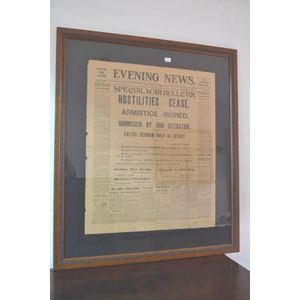French Hunt Mantel Clock with Figural Mount
19th century French ormolu and alabaster mantel clock, figural mount in the form of a huntsman and dog on gilt wood stand
You must be a subscriber, and be logged in to view price and dealer details.
Subscribe Now to view actual auction price for this item
When you subscribe, you have the option of setting the currency in which to display prices to $Au, $US, $NZ or Stg.
This item has been sold, and the description, image and price are for reference purposes only.
- Giltwood - Giltwood is used to describe a gold finish on furniture and other decorative wooden items, whereby a thin sheet of gold metal, called gold leaf, is applied to the surface for decorative purposes.
Unlike gilding, where the gold leaf is applied over a coating of gesso, with giltwood the gold leaf is applied direct to the surface, or over a coat of linseed oil gold leaf adhesive.
Most gold-finished mirrors will be gilded, whereas furniture with gold highlights will have the gold applied through the giltwood method. - Alabaster - Alabaster is soft natural stone used for statuary, with a similar appearance to marble, but easier to work with. As it is softer than marble, an item made from alabaster can be scratched with a metal object, and an alabaster item does not polish to a high surface gloss like marble.
Alabaster objects can be semi-translucent. Alabaster occurs in a pure white form and also with veining from dirt. Colours vary from white through yellow and pink to brown. The veining is usually green or black but can be multicoloured.
Being semi-translucent, alabaster is often used for the bowls of figural lamps, with the figure itself being either alabaster or marble. - Ormolu - Ormolu was popular with French craftsmen in the 18th and 19th century for ornamental fittings for furniture, clocks and other decorative items. True ormolu is gilt bronze, that is bronze that has been coated with gold using a mercury amalgam. Due to the health risks associated with using mercury, this method of creating ormolu was discontinued in France in the 1830s. A substitute was developed consisting of about 75% copper and 25% zinc, however it was inferior to the bronze version. It was often lacquered to prevent it tarnishing.
This item has been included into following indexes:
Visually similar items

World War I framed newspaper 'End of Hostilities'.
Sold by
in
for
You can display prices in $Au, $US, $NZ or Stg.

Victorian cedar side table, with two drawers on bobbin tuned legs, 107 cm wide, 50 cm deep, 76 cm high
Sold by
in
for
You can display prices in $Au, $US, $NZ or Stg.

A pair of World War I leather leggings & full set of sixteen World War I army buttons on card, diameter 1.7 cm
Sold by
in
for
You can display prices in $Au, $US, $NZ or Stg.

A clutch bag by Valentino, styled in green leather with jewelled leopard head clasp, 15 x 30 x 5 cm.
Sold by
in
for
You can display prices in $Au, $US, $NZ or Stg.
